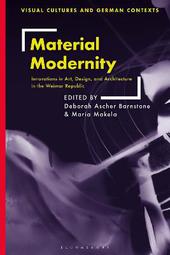
|
Material Modernity: Innovations in Art, Design, and Architecture in the Weimar Republic
Hardback
Main Details
Description
Material Modernity explores creative innovation in German art, design, and architecture during the Weimar Republic, charting both the rise of new media and the re-fashioning of old media. Weimar became famous for the explosion of creative ingenuity across the arts in Germany, due to experiments with new techniques (including the move towards abstraction in painting and sculpture) and inventive work in such new media as paper and plastic, which utilized both new and old methods of art production. Individual chapters in this book consider inventions such as the camera and materials like celluloid, examine the role of new materials including concrete composites in opening up fresh avenues in the plastic arts, and relate advances in the understanding of color perception and psychology to an increased interest in visual perception and the latent potential of color as both architectural ornament and carrier of emotional force in space. While art historians usually argue that experimentation in the Weimar Republic was the result of an intentional rejection of traditional modes of expression in the conscious attempt to invent a modern art and architecture unshackled from historic media and methods, this volume shows that the drivers for innovation were often far more complex and nuanced. It first of all describes how the material shortages precipitated by the First World War, along with the devastation to industrial infrastructure and disruption of historic trade routes, affected art, as did a spirit of experimentation that permeated interwar German culture. It then analyzes new challenges in the 1920s to artistic conventions in traditional art modes like painting, sculpture, drawing, architecture, textiles, and print-making and simultaneously probes the likely causes of innovative new methods of artistic production that appeared, such as photomontage, assemblage, mechanical art, and multi-media art. In doing so, Material Modernity fills a significant gap in Weimar scholarship and art history literature.
Author Biography
Deborah Ascher Barnstone is Professor of Architecture and Head of the School of Architecture, Landscape Architecture, and Interior Architecture at University of Technology Sydney, Australia. She studied at Columbia University, USA and Delft University of Technology, the Netherlands. A licensed architect as well as an art historian, her primary research interests are classical modernism in German art and architecture. Ascher Barnstone has a particular interest in dismantling historical myths by re-examining received histories in order to uncover alternate interpretations of the past. She has published widely in such scholarly publications as Journal of Architectural Education, Journal of Architecture, and New German Critique and in edited volumes. Her recent monograph works include Beyond the Bauhaus: Cultural Modernity in Breslau, 1918-1933 (2016), Art and Resistance in Germany (2018), and The Break with the Past: Avant-garde Architecture in Germany, 1910-1925 (2019). She co-edits the Visual Cultures and German Contexts book series. Maria Makela is Professor Emerita of the California College of the Arts, USA. She holds a PhD in art history from Stanford University. Makela has published widely in exhibition catalogues, edited anthologies, and periodicals on topics as diverse as fashion, rayon, New Objectivity, Dada, Expressionism, film, nationalism, sexology, and typology. Much of her research has focused on gender and sexuality in visual culture. She is the author of The Munich Secession: Art and Artists in Turn-of-the-Century Munich (1990) and co-editor of Of Truths Impossible to Put in Words: Max Beckmann Contextualized (2009). In 1996 she co-curated a traveling retrospective of the work of Hannah Hoech and co-authored the accompanying catalog, The Photomontages of Hannah Hoech. Makela serves on the editorial board of German Quarterly and on the advisory board of the Visual Cultures and German Contexts book series, which publishes under the Bloomsbury Visual Arts imprint.
|